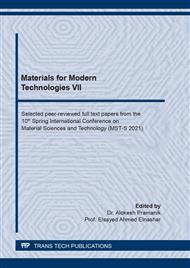[1]
W. Brütting, S. Berleb, A. G. Muckl, Device physics of organic light-emitting diodes based on molecular materials, Org. Electron. 2 (2001) 1-36.
DOI: 10.1016/s1566-1199(01)00009-x
Google Scholar
[2]
L. S. Hung, C. H. Chen, Recent progress of molecular organic electroluminescent materials and devices, Mat. Sci. Eng. R 39 (2002) 143-202.
Google Scholar
[3]
S. K. So, W. K. Choi, L. M. Leung, K. Neyts, Interference effects in bilayer organic light-emitting diodes, Appl. Phys. Lett. 74 (1999) 1939-1941.
DOI: 10.1063/1.123734
Google Scholar
[4]
H. Riel, S. Karg, T. Beierlein, W. Rie, K. Neyts, Tuning the emission characteristics of top-emitting organic light-emitting devices by means of a dielectric capping layer: An experimental and theoretical study, J. Appl. Phys. 94 (2003) 5290-5296.
DOI: 10.1063/1.1605256
Google Scholar
[5]
J. Y. Lee, J. H. Kwon, Enhanced hole transport in C60-doped hole transport layer, Appl. Phys. Lett. 88 (2006) 183502.
DOI: 10.1063/1.2172296
Google Scholar
[6]
Y. Yuan, D. Grozea, Z. H. Lu, Fullerene-doped hole transport molecular films for organic light-emitting diodes, Appl. Phys. Lett. 86 (2005) 143509.
DOI: 10.1063/1.1899241
Google Scholar
[7]
Z. Y. Lü, Z. B. Deng, J. J. Zheng, Y. H. Yin, Y. L. Chen, Y. S. Wang, Organic light-emitting diodes with nanostructured fullerene ultrathin layers, Phys. B 534 (2018) 113-119.
DOI: 10.1016/j.physb.2009.08.077
Google Scholar
[8]
K. Kato, K. Takahashi, K. Suzuki, T. Sato, K. Shinbo, F. Kaneko, H. Shimizu, N. Tsuboi, T. Tadokoro, S. Ohta, Organic light emitting diodes with nanostructured ultrathin layers at the interface between electron- and hole-transport layers, Curr. Appl. Phys. 5 (2005) 321-326.
DOI: 10.1016/j.cap.2004.01.047
Google Scholar
[9]
Y. Liu, X. Wu, Z. Xiao, J. Gao, J. Zhang, H. Rui, X. Lin, N. Zhang, Y. Hua, S. Yin, Highly efficient tandem OLED based on C60/rubrene: MoO3 as charge generation layer and LiF/Al as electron injection layer, Appl. Surf. Sci. 413 (2017) 302-307.
DOI: 10.1016/j.apsusc.2017.04.038
Google Scholar
[10]
General-purpose Photovoltaic Device Model – gpvdm, retrieved from https://www.gpvdm.com/ on 11/19/(2020).
Google Scholar
[11]
D. Xu, Z. Deng, J. Xiao, D. Guo, J. Hao, Y. Zhang, Y. Gao, C. Liang, The effect of C60 doping on the electroluminescent performance of organic light-emitting devices, J. Lumin. 122 (2007) 642-645.
DOI: 10.1016/j.jlumin.2006.01.248
Google Scholar
[12]
C. Williams, S. Lee, J. Ferraris, A. A. Zakhidov, Exciton-dopant and exciton-charge interactions in electronically doped OLEDs, J. Lumin. 110 (2004) 396-406.
DOI: 10.1016/j.jlumin.2004.08.038
Google Scholar


